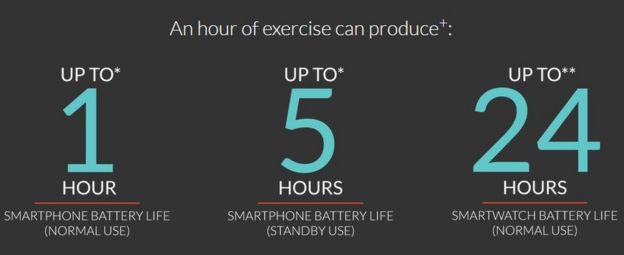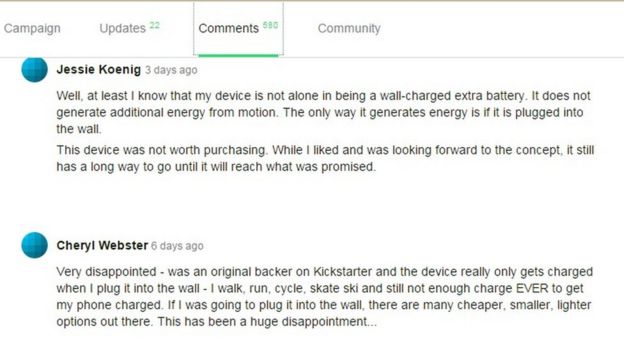
There's growing anger among the supporters of Ampy, a Kickstarter-funded wearable battery charger which promised to "power your devices from your motion" but has been described by disappointed investors as "a deadweight" and "an overpriced brick".
It highlights the risk of investing in product ideas before they have actually launched.
Ampy says the complaints are being made by a small minority.
The battery pack is designed to be worn on the arm or elsewhere around the body.
The idea is that movement shakes internal magnets which generate current that is then stored in the battery. There are three LEDs which indicate how much energy is stored - three lights means it is fully charged.
While this is its main selling point, the Ampy can also be charged by being plugged into the wall.

The battery retails at $100 (£70). The armband costs a further $29 (£20) and there are additional customs fees payable on deliveries outside of the US.
Ampy has received more than $300,000 (£207,000) in crowd funding from 2,573 backers and a further $875,000 (£604,000) in venture capital investment.

The BBC could only find one positive comment on the device's Kickstarter page (it is now closed but investors can still leave feedback) since the Ampy shipped in November 2015.
However, the firm says it has shipped "between 6,000 and 7,000 units" so far, has issued 71 refunds and honoured 68 warrantee claims.
Its reviews on Amazon are polarised with (at time of writing) 39% giving it five stars and 31% one star.
There are 10 five-star reviews. One of those writers said it had changed her life while another described it as "super helpful".
Three of the 10 reviewers have never reviewed anything on Amazon apart from Ampy, according to their profiles. Three more were anonymous and one had not written a single review in more than two years.
Tech news website Cnet awarded it 1.5 stars in a press review.
"No matter what I did, I couldn't get the Ampy to generate any reasonable amount of juice," wrote Sean Hollister.
Jump start
So what's going on?
I decided to buy one myself and find out.
After a 60-minute run I had not even generated enough charge to light the first of the three LEDs.
I then gave it to my children's dad who then wore it during an energetic play in the park with our two sons. When he got back, I jumped on a friend's garden trampoline for half an hour, holding the Ampy and giving it a good shake.
After all that, there was still no LED activity. When I plugged in my phone it charged for just over three minutes but the battery percentage on the phone itself remained unchanged at 67%.
Then I flung it in my handbag where it remained for days while I stomped around with it at work and out with my kids (apparently bag action also counts). Still nothing.
One reviewer, after far more technical tests than mine, and a teardown of the device itself came to the conclusion that it would take "36 hours of activity" to fully charge the Ampy battery itself.
"I think when you tell people you move and then you can charge your phone - people have a high expectation of that and it will seem almost magical," co-founder Alex Smith told me.
"We can say this product isn't for everyone. It is for people who have an active lifestyle".
This however is not explicit on the Ampy website.
He said I should have seen better results from my activities and asked me about the make of my smartphone, how old it was and how bright the screen setting was - all limiting factors in the effectiveness of the device, he said.
"One of the issues is, when this product came out, the most popular phone on the market was iPhone 5. Since then phones have got a lot bigger. The battery is twice as big. Most power from comes from screen size," he added.
'Premium product'
The Ampy is a lifestyle product, Mr Smith continued.
"A Fitbit gives you badges, this gives you battery life," he said.
"We are not promising it is going to replace [charging at the] wall."
On the subject of negative feedback he said it is "often difficult to meet people's expectations".
"We think a lot of our customers are very happy," he added.
"The ones who aren't are the most vocal".
Right idea
Ampy put me in touch with four supportive Kickstarter backers.
They were all pleased to have invested in the concept and liked the device - but three of them admitted that the motion charge they were actually generating was very small.
"I have to wear it all day and maybe I'll be able to charge my phone for five or six minutes," said Di-Lan Sun in the Netherlands.
"But I think it's a great way of doing something with sustainable power. That's important."
Martin Stradling in Canada agreed that the motion charging "wasn't as good" as he expected.
"Everything has to start somewhere.... it's the right idea and a step in the right direction," he said.
Rocco Turso in South Carolina said he kept his Ampy charged via his computer and "topped up" with movement and walker Laurene Beattie said she kept the Ampy in her bag and was able to recharge her phone by up to 50% when needed but added that while she always carried it, she did not use it every day.
Energy harvesting
Clare Grey is a chemistry professor at Cambridge University and an expert on energy storage. I asked her for her thoughts.
By her calculations it would take 13 hours to fully charge the battery of an iPhone 6, based on the current capacity of the Ampy as described on the firm's blog.
"The energy required for [smartphone-like] devices is substantial," she said.
"You're making use of something you're doing anyhow but the general problem with energy harvesting is that all these methods are not very efficient."
However it would be unwise to write off these sorts of devices just yet, she added.
"Energy-harvesting devices have a role to play and will increasingly play a role in the internet-connected lifestyles we will have," Prof Grey said.
A spokesman for Kickstarter said that crowdfunders who invested in hardware products were supporting their development rather than the actual products.
"It's a system that works best when creators are open and honest about their progress and the challenges they're facing," he said in an email.
"There's always a risk that a project won't turn out as planned."



No comments:
Post a Comment